As we count down the days to Christmas, we’ve also been running down our remaining time in Chile and crossing into Peru! Due to the sheer length of Chile, we’ve practically spent half of this time traveling by bus—La Serena to Copaipo to Calama to San Pedro de Atacama to Arica to Tacna to Arequipa to Puno and now to Cusco (roughly 40 hours, I think). That being said, aside from their economic upside, long distance buses here have been surprisingly enjoyable. Fitted with cushy, extra-wide, reclining armchairs, occasionally featuring onboard entertainment comprised of less successful sequel films and mediocre comedy or horror movies dubbed in Spanish, they are certainly more comfortable than the average flight of the same duration. We’ve come to learn that the best bus trips are those when we’re lucky enough to score the top-deck front seats, the prime location to observe passing scenery while enjoying slightly more leg room.
On the 15th, we drove from Copaipo to Calama to San Pedro de Atacama, a journey whose visual impact was nearly as impressive as our actual treks into the desert. For hours, we sped across an empty expanse of sand, winding around dunes and rock formations before catching view of the surprisingly green oasis of San Pedro. Arriving into the town center, we were genuinely so pleased to see the throngs of tourists flocking through the streets entirely populated by little restaurants and dozens of shops hawking colorful souvenirs, outdoor gear, and artisanal goods. After spending over two months having encountered a shockingly small number of other travelers, it was massively reassuring to spend a few days blending in when lugging around our giant backpacks or looking unfortunately white and sunburnt (just Sean, to be clear). On our first evening, we allowed ourselves to be fully immersed in the touristic experience, eating at the busiest restaurant in town, populated exclusively by young Australians and old German couples, where we enjoyed a wonderful menu del día and a few pisco sours.
We opted to explore San Pedro by bike to avoid the steep car rental prices, scoring a 24 hour rental for a brilliantly low total cost of £20. Seeking to avoid the scorching desert heat, we set off in the late afternoon to Valle de Marte/Valle de la Muerte, aptly named after Mars for its extraterrestrial appearance, and accidentally but appropriately misnamed ‘Death Valley’ (due to a misspelling of Marte to Muerte) as there is a distinct lack of most things living, save for a few small birds and ourselves. Despite all efforts to stay hydrated and avoid overheating, we became quickly aware that a litre of water between us was pathetically insufficient. Even as the temperature declined, every sip of water seemed to become entirely obsolete upon swallowing, leaving behind an unquenchable and unpleasantly dry mouth. All dehydration and general dryness was only compounded by the added challenge of the altitude of 2400 meters, though I do think it may have been completely bearable if visiting in cooler months, and Sean seems generally fine, so maybe it is just my lower level of fitness (but let’s attribute it to the altitude). Nevertheless, we made it to the sand dunes and hiked to the top, gleaning a small boost in energy upon encountering a tour group of pensioners (also German) who we simply could not allow ourselves to be surpassed by. The way down was much more pleasant than the way up, and we descended back to the trail by sliding straight down the perfectly smooth side of the dune before speeding back to our accommodation for some much needed hydration. Unfortunately for me, inexperienced and untalented cyclist, the deeper patches of loose sand got the best of me, and I took a most pathetic, slow-motion tumble onto the thankfully quite comfortable ground.

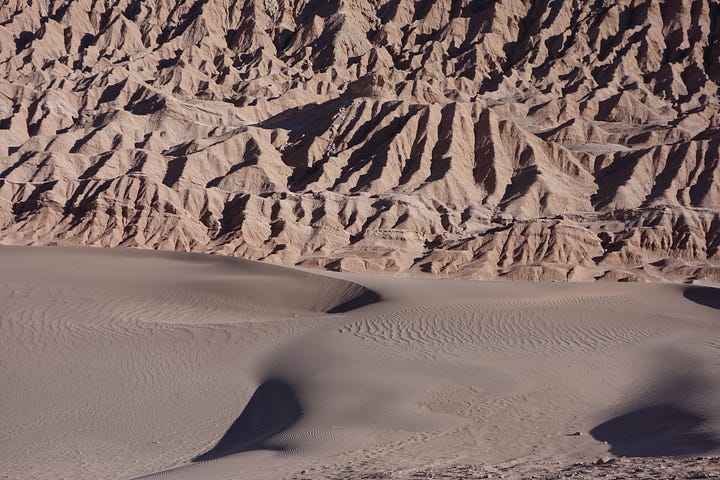
The next morning, emboldened by my squelched fear of falling off the aforementioned bike, we made our way to the Garganta del Diablo (Devil’s Throat). Arriving shortly after opening time, we were surprised to find that we had the park virtually to ourselves, and were able to navigate the winding, walled-in trail quickly and deftly. In my opinion, though this may be slightly skewed by the heat-related discomfort of the previous day, the cycle through Devil’s Throat was much more enjoyable and the visual experience of the cycling route a bit more exciting, though the Devil’s Throat viewpoint couldn’t quite beat that of Death Valley. Reaching the top of the viewpoint of Devil’s Throat was made slightly more entertaining, however, by the arrival of another tourist accompanied by a panting dog, who had apparently followed him nearly an hour from the village through the desert and up the hill, which was quite sweet. On the way back, I was finally vindicated after putting up with Sean making fun of me for not matching his cycling skills, when he so confidently, and so foolishly attempted to make it over a meter high drop in the rock formation and immediately pitched forward, tumbling down over the handlebars. Fortunately for Sean, it happened quite slowly and he was entirely unharmed, so fortunately for me, I could have a good laugh—as did the bike rental man upon our return, who immediately pointed out the tire tread marks emblazoned across Sean’s legs in dust.
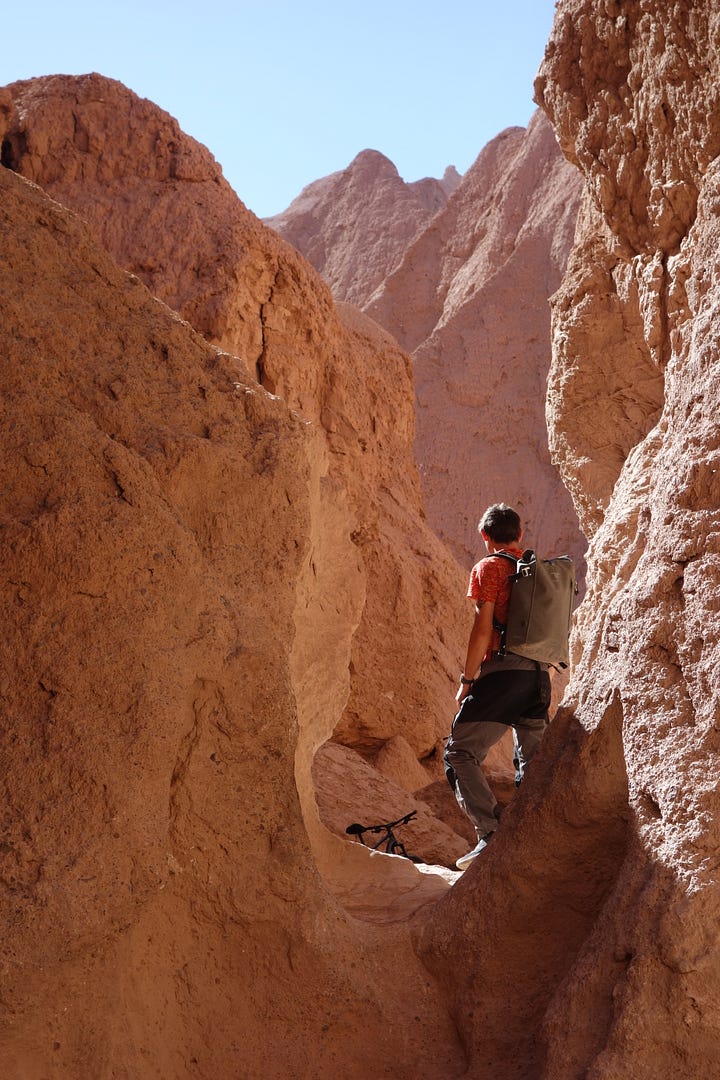
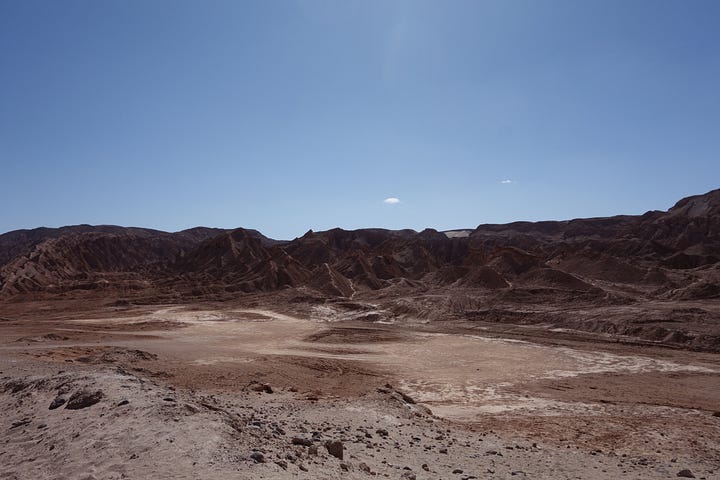
While we had initially thought it a shame that we were only staying in San Pedro for a quick three days, it was definitely sufficient time to see some sights and experience the desert environment (driest nonpolar desert in the world!). Our satisfaction with our experience was cemented during dinner on the second day, where we were flanked on one side by a couple of barefoot Trustafarians, making out incredibly wetly and loudly, a sound that was only masked by the incredibly British man behind us making an even louder scene in English to our poor, flustered, non-English speaking waitress after mistakenly ordering vermouth and subsequently disliking it. While San Pedro attracts a myriad of travelers, from the ever-present Australians, to older, sporty couples, to families with children, the worst of all tourists here, and probably everywhere so far, are the solo or small-group millennials. No matter what nationality, they appear to be universally blissfully unaware of their surroundings and social convention in a stereotypically American abroad-esque manner—leading to many recurring situations similar to this dinner.
After our brief stint in San Pedro, we made our way to Arica, the closest (and beachside!) large city before the Peruvian border. Here, we finally encountered some travellers closer in age to ourselves, one of whom we learned was cycling from Alaska to Argentina—an incredibly impressive feat to hear about after I could barely manage a few hours in the desert. We spent the day relaxing in our hostel and sorting out the mystery of getting to Peru, as there was no sign of the trains and buses which supposedly existed to ferry travellers from Arica to Tacna, in Peru. Regardless, our stay was brief but relaxing, and we ended the day with a swim in surprisingly warm waters off the massive, sandy beach just outside the hostel.

Departing Arica to begin the journey to Puno was definitely the most exciting travel leg we’ve had so far. Beginning at the Arica bus station, we were immediately picked up by a collectivo driver looking to fill the remaining two seats in her car. She drove us up to the border, where we queued with the other three passengers for ages, all entry and exit processing slowed by the spotty internet inside. As far as long border queues go, this one had easily accessible toilets and women selling sandwiches and snacks at various intervals, so the long wait wasn’t too unpleasant. When we finally crossed the threshold into the building, our relief was immediately replaced by genuine shock when, barely 5 meters from actual functioning restrooms, the family in front of us procured a portable toilet out of nowhere and allowed their child to defecate in it, directly in front of the entire queue and half a dozen border guards, which would not have been quite so surprising, if not for the fact that they then proceeded to bag it back up, turd and all, and send it through the luggage scanner as if it was a regular piece of luggage and not a giant plastic bag of kid shit. Our utter surprise certainly shocked us out of our drowsy, post queuing state, and we whizzed through the rest of the border crossing process into Peru!
The excitement of the day did not end there, as halfway through our subsequent bus through the very picturesque Peruvian countryside, we passed a restaurant which appeared to be slightly on fire, after which we immediately began having numerous mechanical issues. A few hours from our destination, we finally stopped and were transferred to another bus—entirely in the dark and on the edge of a cliff. Needless to say, this issue caused us to miss our next bus, so we spent the night in Arequipa before continuing to Puno.
Finally, after two full days of travel, we arrived in our first Peruvian destination! Only in Puno for a quick day, we certainly made the most of it by booking the only kayak tour available to visit the floating islands of Uros on Lake Titicaca. Five minutes before our scheduled pickup time, a woman knocked on the door of our room and shepherded us into a car downstairs, which drove us at breakneck speed to the lake’s edge. Depositing us by a small path, they told us our guide would arrive soon, so we were left to wait, slightly confused, for the arrival of our tour guide. What we expected to be a larger, group tour, turned out to be just us, kayaking across the lake with occasional informational stops with our guide, who jetted ahead in a small speedboat. When we reached the islands, we were met by another guide and a local woman who told us about life on Uros and the history of the floating islands, which was incredibly fascinating. Our guide told us that the hundred or so islands made from chunks of earth and dried reeds housed up to 10 families each, who would resolve conflict by simply slicing off their bit of island and floating away, and translated jokes told by the local woman in Aymara about forgetting to anchor one’s island and waking up back in Bolivia, where the islands’ initial inhabitants had fled from. We ended the tour with a bit more kayaking around the islands, enjoying the perfectly clear, still waters before being ferried back to Puno with another solo kayaker.
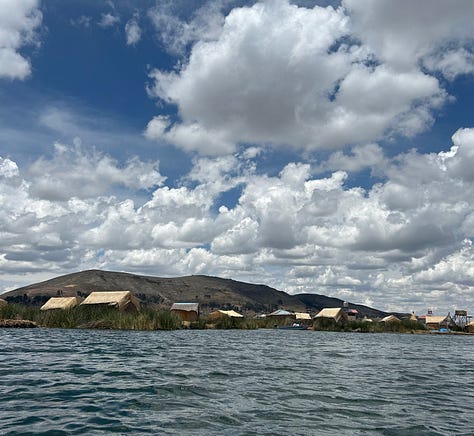
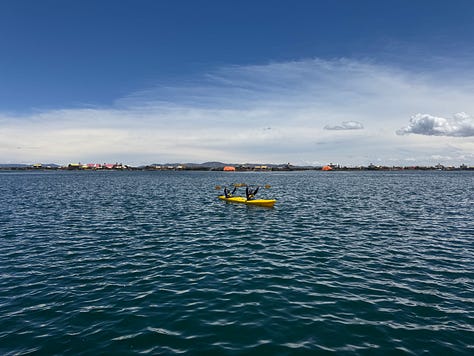
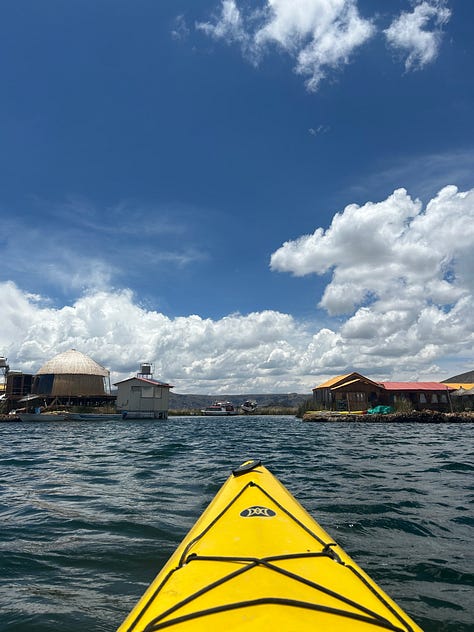
Being away in December has made it slightly difficult to remember the upcoming holidays, but the Christmas spirit in Puno has reinstated our mental calendars. Both nights we ventured into town to witness hoards of locals flooding the square and surrounding streets, watching small parades of teenagers singing, dancing, and playing various instruments under extensive Christmas lights and decorative displays. Their holiday spirit has been great fun to witness, especially that of the boys in the parade, who seemed to keep up their enthusiasm by sporadically trading their reed pipes for shots as they made their way down the street, getting progressively louder and more jubilant as the parade continued.
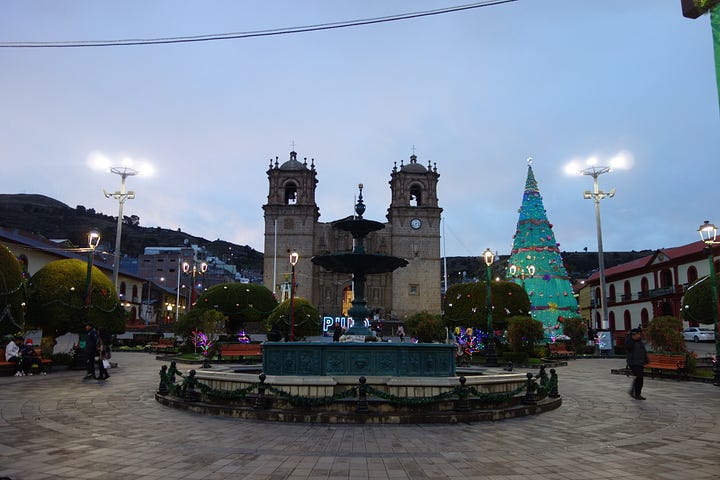
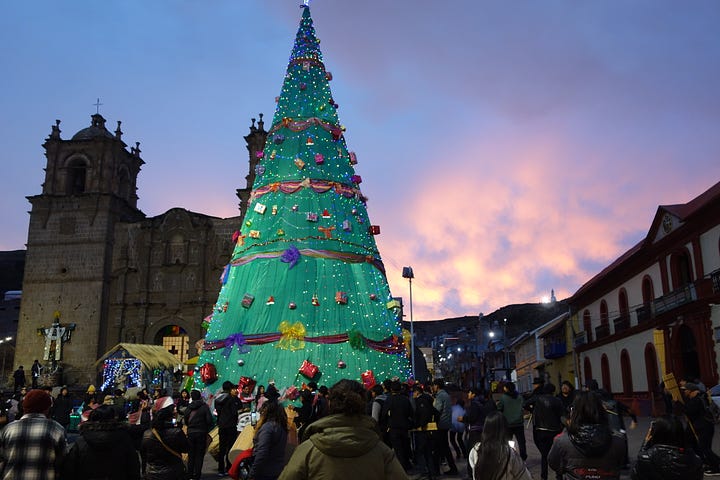
After a nice little lead up to the holidays in Puno, we are now arriving into Cusco to join the thousands of other tourists pouring in to celebrate Christmas. Sean and I will be celebrating our first unsupervised Christmas in two days time by visiting Machu Picchu, a trek which seems appropriately exciting and festive! Happy Christmas Eve Eve!


Hi both, What a lovely and a bit surprising read Sophia. How wonderful to experience these places. Hope you had a lovely Christmas. Keep healthy and sending hugs for more safe travels. Emma and Simon xx